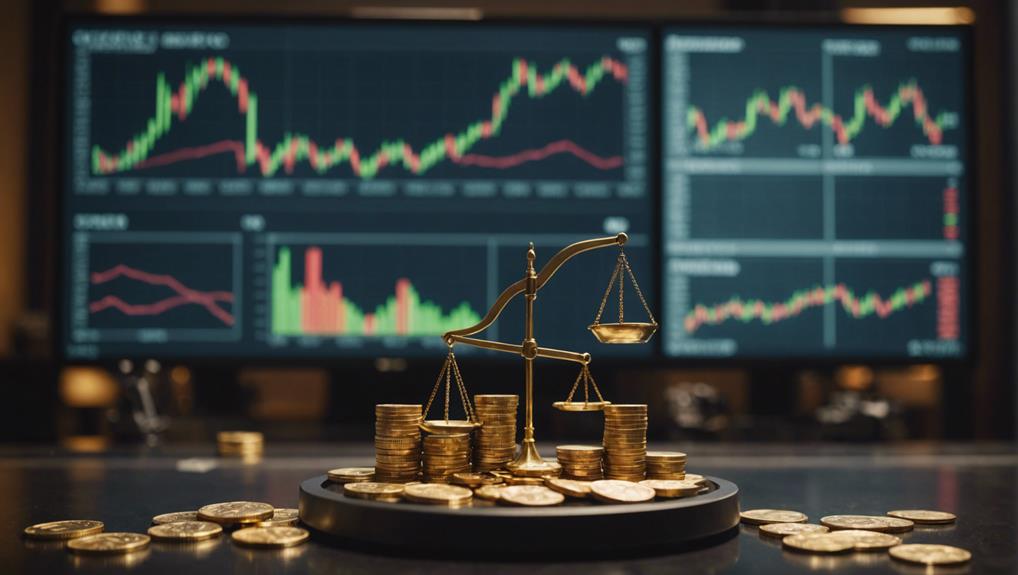When considering investing in Gold ETFs, understanding the associated risks is essential for making informed decisions.
While Gold ETFs provide a convenient way to gain exposure to gold, they also come with counterparty risk and the absence of gold investing benefits.
Management fees can reduce your returns, and tracking errors might cause the ETF to deviate from gold’s price movements.
Liquidity issues can also affect the ease of buying or selling shares.
Additionally, economic and geopolitical factors can significantly impact the performance of Gold ETFs.
My Quick Highlights
- Counterparty risk involves multiple institutions, increasing both the complexity and the potential for failure.
- The absence of physical gold ownership means investors rely on the ETF’s performance and management.
- Tracking errors can lead to deviations from actual gold prices, impacting returns.
- Liquidity risk affects the ease of trading ETF shares and is influenced by market conditions.
- Geopolitical and regulatory factors can significantly impact the performance and operations of gold ETFs.
Counterparty Risk

Investing in gold ETFs involves counterparty risk due to the participation of multiple institutions, such as Authorized Participants, trustees, and custodians. Custodians like HSBC often rely on sub-custodians, introducing additional layers of counterparty risk.
This risk is exacerbated by the key considerations before investing in gold stocks available to trustees against sub-custodians if issues arise with the gold held by the ETF. Custodians generally provide limited insurance coverage for the stored gold, increasing your exposure to potential losses.
The situation is further complicated by the absence of written contractual agreements between sub-custodians and trustees or custodians, which can impact investor protection. Understanding these risks is crucial before investing in gold ETFs.
Lack of Physical Gold Ownership
When you invest in gold ETFs, you don’t own physical gold, only shares in a trust that holds it. This means you don’t have a tangible asset in your hands, which can be a disadvantage during times of crisis.
Furthermore, while physical gold comes with storage costs, owning it directly can provide a sense of security and control that ETFs can’t offer.
No Tangible Asset
Investing in gold ETFs means you don’t own physical gold but rather shares representing a portion of the gold held by the fund. This means you won’t have the tangible asset in your possession.
Instead, your investment relies on the performance and management of the ETF. Without physical gold, you’re exposed to counterparty risks, as the value of your shares depends on the fund’s ability to manage and secure its gold assets.
This financial nature of gold ETFs introduces complexities that differ from holding physical gold, such as coins or bars. Consider these factors carefully when contemplating gold ETFs for your portfolio.
Storage Cost Implications
Opting for gold ETFs eliminates the storage costs typically associated with holding physical gold. With gold ETFs, there’s no need for secure storage facilities, which are essential for physical gold ownership. This removes the financial burden of safeguarding bullion or coins.
ETFs provide exposure to gold prices and offer a convenient alternative, avoiding hefty storage expenses. However, it’s important to note that you won’t own the physical gold itself; rather, you own shares in a fund that holds gold-related assets. This presents both cost-saving benefits and the drawback of lacking tangible ownership.
Management Fees

Before investing in gold ETFs, you need to consider management fees, which can range from 0.17% to 0.85% annually. High fees can eat into your returns over time, especially if you’re holding your investment for the long term.
It’s essential to compare these fees across different ETFs to ensure you’re optimizing your investment returns and avoiding hidden costs.
Expense Ratio Impact
Evaluating gold ETFs requires close attention to the expense ratio, as it directly impacts your investment returns.
Benefits of Investing in Gold ETFs such as SPDR Gold Shares (GLD) and iShares Gold Trust (IAU) often have different expense ratios, which can influence your decision.
The expense ratio, typically averaging around 0.65% annually, covers the fund’s operating costs and management fees.
Lower expense ratios translate to higher net returns for investors.
For example, if GLD has a higher expense ratio than IAU, your returns might be lower with gold ETFs investment.
Monitoring these costs is essential for assessing the overall profitability of your investment.
Comparing the expense ratios of similar gold ETFs ensures you make the most cost-effective choice.
Hidden Costs Analysis
Evaluating expense ratios is crucial, but another significant factor in gold ETF investments is the hidden cost of management fees. Gold ETFs typically have annual management fees averaging around 0.65%. Though seemingly small, these fees can erode your returns over time, particularly for long-term investors.
Comparing fees across different gold ETFs helps you understand their impact on your investment performance. Lower-cost ETFs may offer more cost-effective options in the long run, preserving more of your investment gains.
Monitoring these hidden costs is essential for maximizing returns in gold ETF investments. Always keep an eye on management fees to ensure you get the best value for your money.
Tracking Error
Tracking error measures how much a gold ETF’s performance deviates from the actual price of gold. This deviation can occur due to management fees, trading costs, and differences in investment strategies. Evaluating tracking error is crucial when assessing gold ETFs because it indicates how closely the ETF mirrors gold price movements.
A higher tracking error means the ETF isn’t accurately tracking gold prices, potentially affecting your investment returns. Monitoring this metric allows you to make informed decisions, ensuring the ETF aligns well with the actual performance of gold.
Liquidity Risk

Understanding Liquidity Risk in Gold ETFs
Liquidity risk in gold ETFs pertains to how easily shares can be bought or sold without causing significant price changes. High liquidity, as seen in ETFs like Aberdeen Standard Physical Gold Shares ETF (SGOL) and VanEck Merk Gold Trust (OUNZ), results in tighter bid-ask spreads and lower transaction costs.
Conversely, low liquidity leads to wider spreads and challenges in swiftly exiting positions. Market conditions and trading volumes are crucial determinants of this liquidity. Managing liquidity risk involves:
- Trading Volume: Higher volumes typically indicate better liquidity.
- Bid-Ask Spread: Narrower spreads generally suggest higher liquidity.
- Market Conditions: Volatile markets can adversely affect liquidity.
Tax Implications
Understanding the tax implications of gold ETFs is crucial before making an investment. Taxation of gold ETFs depends on their legal structure and how they track gold prices.
Risks of gold mutual funds like VanEck Merk Gold Trust (OUNZ) and GraniteShares Gold Trust (BAR), which hold physical gold, are taxed as collectibles. This results in higher tax rates compared to regular investments.
In contrast, commodity ETFs that own gold futures contracts follow a special 60/40 tax rule: 60% of gains are taxed at the long-term capital gains rate, and 40% at the short-term rate.
ETFs holding physical gold don’t distribute profits annually, which affects your tax planning. The type of account holding the ETF also significantly influences tax implications.
Market Risk

When investing in gold ETFs, you need to be aware of market risk, primarily driven by price volatility. Economic conditions, geopolitical events, and investor sentiment can all influence gold prices, potentially causing sudden and significant changes.
These fluctuations highlight the importance of understanding the factors affecting gold prices and exploring diversification to mitigate risks.
Price Volatility Concerns
Gold ETFs are subject to significant price volatility due to various economic and geopolitical factors. The value of these investments can fluctuate rapidly, potentially leading to losses during market downturns.
Key points to consider include:
- Economic Conditions: Interest rate changes, inflation, and currency movements can impact gold prices, causing your gold ETFs to swing.
- Geopolitical Events: Political instability or conflict can drive gold prices up, while resolutions can bring them down equally rapidly.
- Market Sentiment: Investor behavior and market trends can lead to sharp price changes, affecting your investment.
Being aware of these risks can help you better prepare for the price volatility associated with gold ETFs.
Economic Impact Factors
Price volatility poses immediate concerns, but broader economic impact factors significantly influence gold ETF performance. Market risk involves various economic indicators, such as GDP growth, unemployment rates, and consumer confidence, all of which can affect gold prices. Inflation, in particular, can erode the value of gold investments, impacting returns on gold ETFs.
A closer look at these factors reveals their interactions:
| Economic Indicator | Impact on Gold ETFs | Example Impact |
|---|---|---|
| GDP Growth | Positive/Negative | Higher growth can reduce gold demand |
| Unemployment Rates | Positive/Negative | Higher unemployment can increase gold demand |
| Inflation | Negative | Erodes investment value |
Understanding these economic factors helps in better assessing the market risk associated with gold ETFs.
Geopolitical Tensions Influence
Geopolitical tensions can significantly impact gold ETF performance by driving investors towards gold as a safe-haven asset. When uncertainties such as trade wars or conflicts arise, gold prices often increase as investors seek stability.
Political instability, sanctions, and global events cause market volatility, affecting gold’s value and, consequently, the performance of your gold ETF investments.
To stay ahead:
- Monitor Geopolitical Developments: Track international news and events.
- Understand Market Reactions: Learn how markets typically respond to various geopolitical scenarios.
- Assess Safe-Haven Appeal: Evaluate gold’s attractiveness as a safe-haven asset during uncertain times.
Regulatory Risk
Regulatory risk in gold ETFs pertains to the potential impact of government regulations on your investment’s performance and operations. Changes in tax laws, trading regulations, or disclosure requirements can significantly influence your gold ETF investment. For example, while the SEC’s oversight ensures compliance, new regulations could increase costs or impose trading restrictions. In severe cases, regulatory shifts might lead to forced liquidation of assets. Staying informed about these developments is crucial to effectively adjust your strategies.
| Potential Regulatory Changes | Impact on Gold ETFs | Investor Action Needed |
|---|---|---|
| Tax Law Changes | Increased costs or liabilities | Review tax implications |
| Trading Regulations | Restrictions on trading | Adjust trading strategy |
| Disclosure Requirements | Increased compliance costs | Ensure compliance |
| SEC Oversight | Changes in structure | Monitor regulatory updates |
| Forced Liquidation | Loss of assets | Prepare for potential exits |
Consistently monitoring regulatory updates is essential to safeguard your investments.
Opportunity Cost

Investing in gold ETFs, such as the Invesco DB Gold Fund (DGL) or ETF Securities Physical Gold ETF (GOLD), can mean missing out on potentially higher returns from other assets like stocks or bonds. While gold often serves as a safe haven during market turbulence, considering the potential gains from other investments is crucial.
- Stocks: Historically, stocks have outperformed gold during economic growth periods.
- Bonds: Bonds offer regular income, which gold ETFs typically don’t provide.
- Diversification: Including a mix of asset classes in your portfolio can help mitigate potential losses and improve overall returns.
Understanding these factors helps make informed decisions about fund allocation.
Diversification Limitations
Have you considered how focusing solely on gold ETFs might restrict your portfolio’s diversification?
Emphasizing options like Sprott Physical Gold Trust (PHYS) or Market Vectors Gold Miners ETF (GDX) exposes your portfolio to risks of investing in gold.
Risks of investing in gold IRAs, including those endorsed by Goldman Sachs, don’t offer the comprehensive exposure that other asset classes like stocks, bonds, or real estate provide.
This limited diversification can increase your portfolio’s risk, especially if investing in gold stocks prices become volatile.
To mitigate this, you might want to diversify with a mix of assets.
Understanding these risks helps you make more informed decisions, ensuring your investment strategy isn’t overly reliant on the gold market’s performance.
Conclusion
Before investing in Gold ETFs, carefully evaluate the various risks involved. Consider counterparty risk, the lack of physical gold ownership, management fees, and tracking error.
Assess liquidity risk, market risk, regulatory risk, and opportunity cost. Be aware of diversification limitations.
By understanding these factors, you’ll be better prepared to make informed decisions and manage your portfolio effectively, ensuring you’re ready for potential market fluctuations and challenges.
The Gold Information Network
11900 Biscayne Blvd, Ste 127B, Miami, FL 33181
(305) 449-9094
https://goldinfo.net







